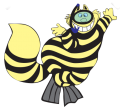Gallipoli, Turkey - 26th April - 3rd May 2025
Five of us met at Manchester airport early on Saturday morning to catch our flight to Istanbul with Turkish Airlines (we met Paul at Istanbul airport as he had gone out earlier for a holiday). The airport is huge and it took some time to get through Immigration before collecting our bags and meeting our bus driver for the 4 hour drive to Eceabat on the Gallipoli peninsula. The drive was interesting and comfortable with comfort stops and an evening meal on the way. We checked in to TJ’s Hotel in Eceabat late on the Saturday evening and were welcomed like old friends. We met our dive guide Ali to discuss the plans for the next day.
After a good night’s sleep and a hearty breakfast, we established our routine for the week: breakfast at 8.30am, leave the hotel at 10.30am and get onto the bus for the drive to the harbour to get on the boat. Our dives were in the northern sector of the Gallipoli Historical site for the first half of the week, and in the southern sector (near the entrance to the Dardanelles strait) at the end of the week. The days were long with 2 dives (generally before and after a fabulous meal prepared by the skipper) but the scenery was stunning and company was good. We returned to the harbour in the early evening to be greeted by the pack of Turkish shepherd dogs which guarded the boat and we were then transported back to the hotel for dinner, beers and lots of conversation!
Ali’s dive boat, Blackfish, had a good sized deck with plenty of room for us to kit up, a large indoor cabin which we were allowed to sit in, even in our dry suits, and a top sun deck. The weather was very windy and we were blown out on the second day. Consequently we were glad of the indoor space. Ali was accompanied by John, a marine biologist who translated for us, and there were other crew members each day who helped us in and out of the water, in addition to the skipper.
Many of the Gallipoli wrecks are relatively deep and there are strong currents around some of them. In addition, the winds were strong resulting in a lot of swell. We managed to dive on the Sunday morning but then the second dive was aborted due to the strengthening winds. Monday was blown out but we changed our plans for the week and did our trip to Ancient Troy on the Monday. Conditions improved a little over the rest of the week but swell was a problem on many of the dives. Friday was a lovely calm day but we could only do 1 dive as we were flying home at 2pm on Saturday.
Dive sites:
We dived the following wrecks over the week, accompanied in the water by Ali and John:
HMS Louis, a destroyer, wrecked in Suvla Bay on October 31st, 1915. 13m depth. The Yarrow steam boilers are visible although much of the wreck is under the sand.
Ariburnu Barge, probably used to transport animals, sank in Anzac Cove, 29m depth.
Ariburnu Landing craft, used for transportation between the ships moored off-shore and the coast. Sunk in Anzac Cove during the retreat in December 1915, 21m depth.
HMS Lundy, a trawler commandeered by the British Navy and armed for use as a patrol boat. Sank following a collision with the SS Kaylan which was delivering troops and freight on August 16th, 1915. Suvla Bay. 28m depth – the most intact wreck and a stunning dive.
SS Milo, grounded by its crew on October 26th 1915 to create a breakwater adjacent to Anzac Cove. 5m depth – this was like diving in an aquarium surrounded by shoals of fish.
HMS Majestic, a battleship which joined the Dardanelles Force in February 1915 and remained in Gallipoli for moral support after the landing on April 25th 1915. HMS Majestic was torpedoed by the German submarine U-21 on May 27th 1915 at Cape Helles with the loss of 49 men. 23m depth.
Helles Barges, used to transport soldiers, supplies and mounts for the pier constructions during the Gallipoli landings. The barges were sunk during the landing at Seddulbahir on April 25th 1915. 25m depth.

In addition to the diving, we were given tours to some of the battlefields and war memorials of the Gallipoli peninsula. On our final afternoon, TJ, Ali and John came showed us around the British and Turkish memorials in the southern sector and took us to several small museums in the area. The whole of the Gallipoli peninsula and the Historical Underwater Park are war graves and bones continue to be found or washed ashore 110 years after the event. It was very moving to learn of the battles and hardships of that doomed campaign, especially the enormous and futile loss of so many lives.
We also enjoyed a day out to the Ancient city of Troy, first settled in around 3600 BC and repeatedly destroyed and rebuilt. This archeological site is now a UNESCO World Heritage Site.
This was an excellent trip and we all enjoyed the combination of diving and sight-seeing, especially the chance to visit Ancient Troy. All meals and travel to and from the boat were included and we were really well looked after. Buddy pairs were Steve Marriott and Jane Sheldon, Paul Callis and Nikki Tomes, Loz Broome and Alison Brammer.
Diving was with BYEM Dive Centre and we stayed at TJ’s Hotel in Eceabat.
Thanks to Steve for organising this trip and to our Turkish friends, TJ, Ali & John for their friendliness and wonderful hospitality.
Trip report & photos – Alison Brammer



















Yarrow boiler on HMS Louis
ANZAC landing craft with Paul & Nikki & shoals of fish
Scorpion fish on HMS Lundy
